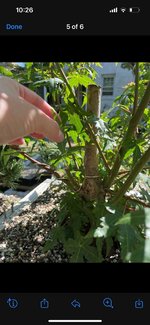So here's a real newb question - when one is ready to develop branching, what is the best way to replace the existing larger branches? For example, I want a branch in the place where a branch is currently growing, but that branch has grown way too fat (and/or with too large internodes). Are these simply pruned back and new shoots allowed to grow from the base of that branch or is there more to this? Is it cut back flush or back to the first node?
The trident maples seem to send out shoots from a stub as well as when I prune it flush. How about JMs?
For a more specific scenario, attached is a pic of a JM tree that is the subject of another thread. I want to eventually grow a new branch to replace the wired branch on the left of the pic so that I have much smaller internodes. A graft is always possible, but is this needed here? How can I accomplish this?
The trident maples seem to send out shoots from a stub as well as when I prune it flush. How about JMs?
For a more specific scenario, attached is a pic of a JM tree that is the subject of another thread. I want to eventually grow a new branch to replace the wired branch on the left of the pic so that I have much smaller internodes. A graft is always possible, but is this needed here? How can I accomplish this?

